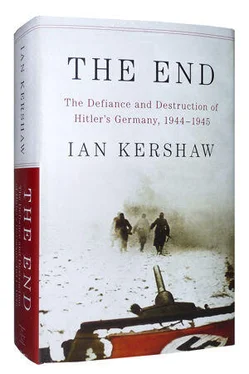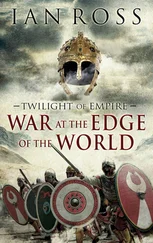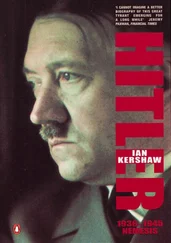Denny, Isabel, The Fall of Hitler’s Fortress City: The Battle for Königsberg, 1945 , London, 2007.
D’Este, Carlo, ‘Model’, in Correlli Barnett (ed.), Hitler’s Generals , London, 1990.
Das Deutsche Reich und der Zweite Weltkrieg , vols. 7–10, ed. Militärgeschichtliches Forschungsamt, Munich, 2004–8.
Der deutsche Südwesten zur Stunde Null , ed. Generallandesarchiv Karlsruhe, Karlsruhe, 1975.
Deutschland im Zweiten Weltkrieg , vol. 6: Die Zerschlagung des Hitlerfaschismus und die Befreiung des deutschen Volkes (Juni 1944 bis zum 8. Mai 1945) , ed. Authors’ Collective under the direction of Wolfgang Schumann and Olaf Groehler, with assistance from Wolfgang Bleyer, Berlin, 1985.
Deutschlands Rüstung im Zweiten Weltkrieg: Hitlers Konferenzen mit Albert Speer 1942–1945 , ed. Willi A. Boelcke, Frankfurt am Main, 1969.
Dieckert, Kurt, and Grossmann, Horst, Der Kampf um Ostpreußen: Ein authentischer Dokumentarbericht , Munich, 1960.
Dönitz, Karl, Memoirs: Ten Years and Twenty Days , Da Capo edn., New York, 1997.
Dörr, Margarete, ‘Wer die Zeit nicht miterlebt hat …’: Frauenerfahrungen im Zweiten Weltkrieg und in den Jahren danach , vol. 3, Frankfurt am Main and New York, 1998.
Downing, David, The Devil’s Virtuosos: German Generals at War 1940–5 , London, 1977.
Echternkamp, Jörg, ‘Im Kampf an der inneren und äußeren Front: Grundzüge der deutschen Gesellschaft im Zweiten Weltkrieg’, in DRZW , vol. 9/1.
—— (ed.), Kriegsschauplatz Deutschland 1945: Leben in Angst—Hoffnung auf Frieden. Feldpost aus der Heimat und von der Front , Paderborn, 2006.
Eichholtz, Dietrich, ‘Deutschland am Ende des Krieges: Eine kriegswirtschaftliche Bilanz’, Bulletin der Berliner Gesellschaft für Faschismus- und Weltkriegsforschung , 6 (1996).
—— Geschichte der deutschen Kriegswirtschaft 1939–1945 , vol. 3: 1943–1945 , Berlin, 1996.
Elliger, Katharina, Und tief in der Seele das Ferne: Die Geschichte einer Vertreibung aus Schlesien , Reinbek bei Hamburg, 2006.
Epstein, Catherine, Model Nazi: Arthur Greiser and the Occupation of Western Poland , Oxford, 2010.
Erickson, John, The Road to Berlin , Cassell edn., London, 2003.
Erpel, Simone, ‘Machtverhältnisse im Zerfall: Todesmärsche der Häftlinge des Frauen-Konzentrationslagers Ravensbrück im April 1945’, in Jörg Hillmann and John Zimmermann (eds.), Kriegsende 1945 in Deutschland , Munich, 2002.
—— Zwischen Vernichtung und Befreiung: Das Frauen-Konzentrationslager Ravensbrück in der letzten Kriegsphase , Berlin, 2005.
Eschenburg, Theodor, ‘Die Rede Himmlers vor den Gauleitern am 3. August 1944’, Vf Z , 1 (1953).
Evans, Richard, The Third Reich at War , London, 2008.
Fest, Joachim C., The Face of the Third Reich , Harmondsworth, 1972.
—— Speer: Eine Biographie , Berlin, 1999.
Fisch, Bernhard, Nemmersdorf, Oktober 1944: Was in Ostpreußen tatsächlich geschah , Berlin, 1997.
—— ‘Nemmersdorf 1944—ein bisher unbekanntes zeitnahes Zeugnis’, Zeitschrift für Ostmitteleuropa-Forschung , 56 (2007).
Fleischhauer, Ingeborg, Die Chance des Sonderfriedens: Deutsch-sowjetische Geheimgespräche 1941–1945 , Berlin, 1986.
Förschler, Andreas, Stuttgart 1945: Kriegsende und Neubeginn , Gudensberg-Gleichen, 2004.
Förster, Jürgen, ‘Geistige Kriegführung in Deutschland 1919 bis 1945’, in DRZW , vol. 9/1.
—— ‘Die Wehrmacht und das Ende des “Dritten Reichs”’, in Arnd Bauerkämper, Christoph Kleßmann and Hans Misselwitz (eds.), Der 8. Mai 1945 als historische Zäsur: Strukturen, Erfahrung, Deutungen , Potsdam, 1995.
—— ‘The Final Hour of the Third Reich: The Capitulation of the Wehrmacht’, Bulletin of the International Committee for the History of the Second World War , Montreal (1995).
—— Die Wehrmacht im NS-Staat: Eine strukturgeschichtliche Analyse , Munich, 2007.
Friedländer, Saul, The Years of Extermination: Nazi Germany and the Jews, 1939–1945 , London, 2007.
Friedrich, Carl Joachim, and Brzezinski, Zbigniew, Totalitarian Dictatorship and Autocracy , Cambridge, Mass., 1956.
Friedrich, Jörg, Der Brand: Deutschland im Bombenkrieg 1940–1945 , pb. edn., Berlin, 2004.
Frieser, Karl-Heinz, ‘Die Schlacht um die Seelower Höhen im April 1945’, in Roland G. Foerster (ed.), Seelower Höhen 1945 , Hamburg, 1998.
—— et al. , ‘Der Zusammenbruch im Osten: Die Rückzugskämpfe seit Sommer 1944’, in DRZW , vol. 8.
Fritsche, Peter, Life and Death in the Third Reich , Cambridge, Mass., and London, 2008.
Fritz, Stephen G., Endkampf: Soldiers, Civilians, and the Death of the Third Reich , Lexington, Ky., 2004.
Fröhlich, Elke, ‘Ein junger Märtyrer’, in Martin Broszat, Elke Fröhlich et al. (eds.), Bayern in der NS-Zeit , vol. 6, Munich and Vienna, 1983.
—— ‘Hitler und Goebbels im Krisenjahr 1944: Aus den Tagebüchern des Reichspropagandaministers’, Vf Z , 39 (1990).
‘Führer-Erlasse’ 1939–1945 , ed. Martin Moll, Stuttgart, 1997.
Gellately, Robert, Backing Hitler: Consent and Coercion in Nazi Germany , Oxford, 2001.
Geyer, Michael, ‘ Endkampf 1918 and 1945: German Nationalism, Annihilation, and Self-Destruction’, in Alf Lüdtke and Bernd Weisbrod (eds.), No Man’s Land of Violence: Extreme Wars in the 20th Century , Göttingen, 2006.
Goebbels, Joseph, Tagebücher 1945: Die letzten Aufzeichnungen , Hamburg, 1977.
Goeschel, Christian, ‘Suicide at the End of the Third Reich’, Journal of Contemporary History , 41 (2006).
—— Suicide in Nazi Germany , Oxford, 2009.
Göhri, Josef F., Die Franzosen kommen! Kriegsereignisse im Breisgau und in der Ortenau , Horb am Neckar, 2005.
Goldhagen, Daniel Jonah, Hitler’s Willing Executioners: Ordinary Germans and the Holocaust , pb. edn., London, 1997.
von der Golz, Anna, Hindenburg: Power, Myth, and the Rise of the Nazis , Oxford, 2009.
Görlitz, Walter, Model: Strategie der Defensive , Wiesbaden, 1975.
Gotto, Bernhard, Nationalsozialistische Kommunalpolitik: Administrative Normalität und Systemstabilisierung durch die Augsburger Stadtverwaltung 1933–1945 , Munich, 2006.
Granzow, Klaus, Tagebuch eines Hitlerjungen 1943–1945 , Bremen, 1965.
Greiser, Katrin, Die Todesmärsche von Buchenwald: Räumung, Befreiung und Spuren der Erinnerung , Göttingen, 2008.
Grieger, Friedrich, Wie Breslau fiel … , Metzingen, 1948.
Grier, Howard D., Hitler, Dönitz and the Baltic Sea: The Third Reich’s Last Hope, 1944–1945 , Annapolis, Md., 2007.
Gring, Diana, ‘Das Massaker von Gardelegen’, Dachauer Hefte , 20 (2004).
Groehler, Olaf, ‘Die Schlacht um Aachen (September/Oktober 1944)’, Militärgeschichte (1979).
—— Bombenkrieg gegen Deutschland , Berlin, 1990.
Grosche, Robert, Kölner Tagebuch 1944–46 , Cologne, 1969.
Gruchmann, Lothar, Der Zweite Weltkrieg , pb. edn., Munich, 1975.
Guderian, Heinz, Panzer Leader , Da Capo edn., New York, 1996.
Haase, Norbert, ‘Justizterror in der Wehrmacht’, in Cord Arendes, Edgar Wolfrum and Jörg Zedler (eds.), Terror nach Innen: Verbrechen am Ende des Zweiten Weltkrieges , Göttingen, 2006.
Читать дальше












